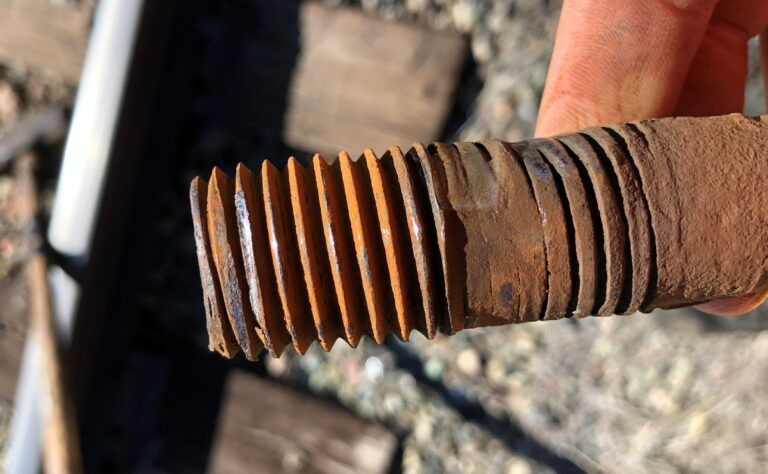You shouldn’t need a locknut if the bolted joint is properly designed and assembled. This means it’s designed to hold the working load, is tightened to the specified value, and the preload force is maintained. This seems simple enough. If this is achieved, vibration forces are not likely to overcome the friction constraints in the threads or between the contact surface faces of the nut and the joint and the nut will stay tight.
Here is an example of what can happen if the preload is not maintained.

A track bolt damaged by the effects of losing preload on the bolted joint.
You do need a locknut if any of the factors below prevent the bolted joint from maintaining the full pre-load tension and vibration, impact, or load forces cause the nut to move.
As we’ve outlined in previous posts about torque, clamp force, rotation angle, and bolt stretch, getting this right is far more complicated than it appears. Here are just a few of the dozens of factors that can, and often do, contribute to bolted joint loosening.
Detailed below are:
Inaccurate K factor
Short clamp length
Uneven clamp surfaces
Material relaxation & embedding
Tool accuracy
Worn tools and sockets
Inaccurate K Factor
The amount of torque that is applied to achieve a specified clamp load is directly dependent on the friction and other mechanical factors in the threads and joint assembly. All these factors are captured in a single value called “K”. The simple formula is torque = (clamp load) x (bolt diameter) x (K). For accurate results, the K factor must be exactly determined using force measurement equipment matching the exact field conditions. This is often done in high volume, controlled, manufacturing environments but is rarely done for most bolted joints. Most often the K factor is estimated. This value can be off by as much as a factor of 2 which results in 1/2 the clamp force.

Use this downloadable spreadsheet to see how the K factor affects clamp load for any size bolt.
Short Clamp Length
This by itself is not really a problem. The problem when you have a short clamp distance, or more specifically a large diameter/length ratio, is it makes it much more difficult to achieve the correct bolt tension. For example, on a 3/4″ x 10, Grade 5, bolt with a 3/4” clamp distance (ratio = 1) the bolted joint increases from zero tension to fully tightened with only 6 degrees of nut rotation and the bolt only stretches 0.002”. This is very difficult to manage even under the most controlled conditions. Most often this type of joint is under or over tightened leaving it vulnerable to vibration loosing.

Uneven Clamp Surfaces
When clamp joints are uneven, there are several factors that can affect the clamp force. The face of the nut will not compress evenly on the clamp surface. This can cause higher sliding friction between the nut face and the clamp surface. Also, as the nut is tightened, energy is required to bend the bolt, resulting in high stresses a shown in the illustration below.

FEA analysis from “Stress Analysis of Bolted Joints,” László Molnár, et. al. showing stress in mating screw threads (David Archer, assemblymag.com)
Material Relaxation & Embedding
Initial relaxation occurs as a result of vibration, creep, embedding (next paragraph), and material expansion due to temperature, among other factors.

Within a tightened bolted joint, the thread contact surfaces experience high pressure which may plastically deform the material and reduce preload. The rough mating surfaces are smoothed out over a period of time. This is called embedding. Additional embedding can occur between the bolt head and/or the nut and their contact surfaces, whether they be soft materials (composites) or hard materials (polished metals).

Image: Felix Chen, Ph.D.
Some steps to take to reduce the amount of bolted joint relaxation:
Maintain better perpendicularity (as discussed above)
Retighten nuts after first use to account for preload loss during relaxation
Tool Accuracy
There is a significant amount of variance in torque control depending on the type of equipment used. As seen in the chart below, one of the most common types of installation tools has a tension scatter as high as 60%.

Worn Tools and Sockets
The accuracy of the tools above, especially for impact type wrenches, can be further compromised if the tools and sockets aren’t properly maintained and replaced as they wear. Here’s an example of a new and worn socket.

So, How Do Locknuts Help?
Prevailing torque locknuts serve as a safety net, so to speak. No two types of locknuts are created equally and some work significantly better than others. We will explore these differences in upcoming articles. The bottom line is if conditions are imperfect and system vibration and/or cyclical loading causes the bolted joint tend toward losing preload, a locknut can prevent the nut from spinning the slight amount it takes to become ineffective.
Comments